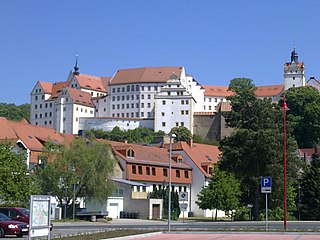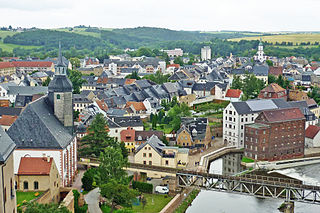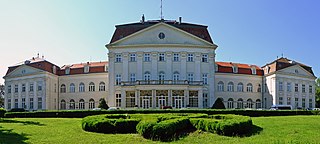
Osterstein Castle (German : Schloss Osterstein, lit. 'Eastern Rock') is the former castle of the town of Zwickau, Germany, in Saxony (Bundesland Sachsen). Now it houses a nursing home.

Osterstein Castle (German : Schloss Osterstein, lit. 'Eastern Rock') is the former castle of the town of Zwickau, Germany, in Saxony (Bundesland Sachsen). Now it houses a nursing home.
First mentioned in 1292 as "Castrum Czwickaw", it was badly damaged in a fire in 1403, and demolished between 1404 and 1407 under William I, Margrave of Meissen. It was rebuilt during the reign of Christian I, Elector of Saxony in 1587-1590 as a magnificent Renaissance castle.
In the 18th century, Zwickau Prison (Zuchthaus Zwickau) was established in the castle, which with interruptions, was used until after the Second World War. There were numerous prominent prisoners, including Karl May, August Bebel, Rosa Luxemburg and Martin Hoop.
During the Second World War, it was used as a concentration camp. [1] On 31 December 1962, after 187 years, the use of the castle as a prison ended, although a public bathhouse continued to operate in an intermediate wing of modern construction, on the Dr.-Friedrich-Ring. The former arsenal and the cell block were used to house the archives of the local coal mining industry, and for storage by various local businesses. Parts of the premises were demolished.
From the 1980s, the castle structure deteriorated rapidly. During the 1990s and into the early years of the 21st century, proposals for its reuse and plans for reconstruction and redevelopment repeatedly came to nothing. The castle became increasingly a blot on the urban landscape of Zwickau town centre, and a cause of civic embarrassment. After 2000, emergency measures were required to secure the building's safety.
On 3 November 2006, the foundation stone was laid for the reconstruction of the castle. The work was undertaken by GP Schuppertbau GmbH, who after repair, restoration and rebuilding converted the former castle into a nursing home, with future plans for some parts of the complex for restaurant and museum use. On 9 September 2007, the topping-out ceremony took place. On 7 November 2008, the keys were formally handed over to the Betreibergesellschaft Senioren- und Seniorenpflegeheim GmbH Zwickau, the company that runs a senior citizen's home and nursing home; the first residents moved in on 11 November 2008.
Coordinates: 50°43′16″N12°30′01″E / 50.7210166667°N 12.5003638889°E

Zwickau (German pronunciation: [ˈtsvɪkaʊ]; is, with around 87,500 inhabitants, the fourth-largest city of Saxony after Leipzig, Dresden and Chemnitz and it is the seat of the Zwickau District. The West Saxon city is situated in the valley of the Zwickau Mulde, and lies in a string of cities sitting in the densely populated foreland of the Elster and Ore Mountains stretching from Plauen in the southwest via Zwickau, Chemnitz and Freiberg to Dresden in the northeast. From 1834 until 1952, Zwickau was the seat of the government of the south-western region of Saxony.

Cottbus or Chóśebuz is a university city and the second-largest city in the German state of Brandenburg after the state capital of Potsdam. With around 98,000 inhabitants, it is the most populous city in Lusatia. Cottbus lies in the Sorbian settlement area of Lower Lusatia, and is the second-largest city on the River Spree after Berlin, from which it is situated around 125 km (78 mi) upstream. The city is located on the shores of Cottbus Eastern Lake, which will be Germany's largest artificial lake by surface area when flooding is completed.

Colditz is a small town in the district of Leipzig, in Saxony, Germany. It is best known for Colditz Castle, the site of the Oflag IV-C POW camp for officers in World War II.

Castle Colditz is a Renaissance castle in the town of Colditz near Leipzig, Dresden and Chemnitz in the state of Saxony in Germany. The castle is between the towns of Hartha and Grimma on a hill spur over the river Zwickauer Mulde, a tributary of the River Elbe. It had the first wildlife park in Germany when, during 1523, the castle park was converted into one of the largest menageries in Europe.

The Zwickauer Mulde is a river in Saxony, Germany. It is the left tributary of the Mulde and 166 km (103 mi) in length.

Gera is a city in the German state of Thuringia. With around 93,000 inhabitants, it is the third-largest city in Thuringia after Erfurt and Jena as well as the easternmost city of the Thüringer Städtekette, an almost straight string of cities consisting of the six largest Thuringian cities from Eisenach in the west, via Gotha, Erfurt, Weimar and Jena to Gera in the east. Gera is the largest city in the Vogtland, and one of its historical capitals along with Plauen, Greiz and Weida. The city lies in the East Thuringian Hill Country, in the wide valley of the White Elster, between Greiz (upstream) and Leipzig (downstream). Gera is located in the Central German Metropolitan Region, approximately 60 kilometres south of Saxony's largest city of Leipzig, 80 km east of Thuringia's capital Erfurt, 120 km west of Saxony's capital Dresden and 90 km north of Bavaria's city of Hof (Saale).
Greiz is a Kreis (district) in the east of Thuringia, Germany. Neighboring districts are Saale-Holzland, Saale-Orla, district-free city Gera, the Burgenlandkreis in Saxony-Anhalt, Altenburger Land, and the two Saxon districts Zwickau and Vogtlandkreis.

The Berlin Palace, formally the Royal Palace, on the Museum Island in the Mitte area of Berlin, was the main residence of the House of Hohenzollern from 1443 to 1918. Expanded by order of King Frederick I of Prussia according to plans by Andreas Schlüter from 1689 to 1713, it was thereafter considered a major work of Prussian Baroque architecture. The former royal palace is one of Berlin’s largest buildings and shaped the cityscape with its 60-meter-high (200 ft) dome.

Altenburg is a city in Thuringia, Germany, located 40 kilometres south of Leipzig, 90 kilometres west of Dresden and 100 kilometres east of Erfurt. It is the capital of the Altenburger Land district and part of a polycentric old-industrial textile and metal production region between Gera, Zwickau and Chemnitz with more than 1 million inhabitants, while the city itself has a population of 33,000. Today, the city and its rural county is part of the Central German Metropolitan Region.

Ohrdruf is a small town in the district of Gotha in the German state of Thuringia. It lies some 30 km southwest of Erfurt at the foot of the northern slope of the Thuringian Forest. The former municipalities Crawinkel, Gräfenhain and Wölfis were merged into Ohrdruf in January 2019.

Aue is a small town in Germany at the outlet of the river Schwarzwasser into the river Zwickauer Mulde in the Ore Mountains, and has roughly 16,000 inhabitants. It was merged into the new town Aue-Bad Schlema in January 2019. Aue was the administrative seat of the former district of Aue-Schwarzenberg in Saxony, and is part of the Erzgebirgskreis since August 2008. It belongs to the Silberberg Town League

Reinhardsbrunn in Friedrichroda near Gotha, in the German state of Thuringia, is the site of a formerly prominent Benedictine abbey, the house monastery of the Ludovingian Landgraves of Thuringia abbey extant between 1085 and 1525. Later used as an administrative seat by the Ernestine dukes of Saxony, the property was turned into a castle and park erected by the Dukes of Saxe-Coburg and Gotha from 1827.

Rochlitz is a major district town in the district of Mittelsachsen, in Saxony, Germany. Rochlitz is the head of the "municipal partnership Rochlitz" with its other members being the municipalities of Königsfeld, Seelitz and Zettlitz.

Lengenfeld is a town in the Vogtlandkreis district, in the Free State of Saxony in eastern Germany. The town is situated 19 km southwest of Zwickau, and 18 km northeast of Plauen.

Martin Hoop was a district leader in the Communist Party of Germany in Saxony and a supporter of the Weimar Republic presidential candidate Ernst Thälmann.

Wilhelminenberg Castle is a former palace dating from the early 20th century, which is now a four-star hotel, restaurant and conference facility. It is situated on the eastern slopes of the Gallitzinberg, in the Wienerwald western parts of the Austrian capital, Vienna.
In Nazi Germany, Sonder- und Ehrenhaft was an administrative status assigned to certain particularly prominent political prisoners, notably political leaders of Nazi-occupied countries and disgraced members of the German elite. Because of their political value or former status, they were treated uncommonly well, and all but a few of them survived the war.

The hunting lodge of Augustusburg was built from 1568 to 1572 above the town of the same name on a hill called the Schellenberg on the northern edge of the Ore Mountains of Germany. The castle, which is visible from afar, is a local landmark. It lies about 12 kilometres east of the city of Chemnitz and about 21 kilometres southwest of Freiberg in the Free State of Saxony.

Schloss Köthen is a palace (schloss) in Köthen (Anhalt), Germany. Begun as a castle, it was protected by a moat. It was the residence of the Princes and Dukes of Anhalt from 1244 to 1847, and now belongs to a foundation for the preservation of sites in Saxony-Anhalt.

Rochsburg Castle, which was probably founded in the late 12th century, stands on a rock spur, surrounded on three sides by the Zwickau Mulde river, above the eponymous town quarter in Lunzenau in Saxony. The medieval site and its division into the inner bailey, outer bailey and two zwingers is still easy to recognise. In its present appearance the schloss dates, however, to the Late Gothic and Renaissance periods. Its main construction phases date to 1470 and 1548; it is an important example of Renaissance architecture in Saxony. Over centuries the Rochsburg has formed the centrepiece in the Saxon district of Rochsburg.